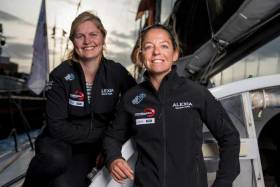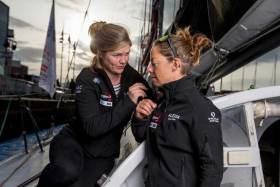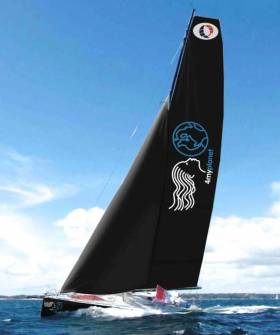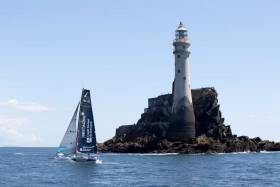Displaying items by tag: Joan Mulloy
The Famous Project crew have completed on their first all-female ocean passage across the Atlantic on their MOD70 The Famous Project Limosa.
The seven-strong crew — which included Ireland’s own Joan Mulloy — arrived in Portimao, Portugal from Antigua on Wednesday (24 April) to complete one of their main objectives ahead of the Jules Verne Trophy next year.
This Transatlantic passage was co-skippered by project founder Alexia Barrier (FRA) and Dee Caffari (GBR) with a crew comprising Marie Riou (FRA), Deborah Blair (GBR), Annie Lush(GBR), Rebecca Gmuer (NZL), Joan Mulloy (IRL) and media reporter Georgia Schofield (NZL).
Ireland’s Pamela Lee is also involved with the team but did not complete this passage, dedicating herself more recently to the final selection phase of the UpWind by MerConcept project, aimed at building a 100-per-cent female crew on the Ocean Fifty UpWind skippered by Francesca Clapcich.
In part, the Famous Project’s Transat helped in the training and future selection of the 10-strong team which will sail the giant multihull Ultim IDEC SPORT non-stop around the world during the winter of 2025.
For former Vendée Globe solo ocean racer turned team leader Barrier, it was also another big step in her own personal transition from lone single-handed racing to skippering a strong team of women on a high-speed multihull for the first time.
“I discovered myself as a captain,” Barrier said. “Certainly, we have not pushed the boat to its limits. We didn’t look to make it hard for ourselves either. The main idea was to build cohesion and good understanding between us eight women who had very little sailing time together, even if we all knew each other individually.
“As far as I was concerned, it was important for me to prove to myself that I knew how to take on the role of captain and leader. It seems tome that on these two counts, our Transat is a success.
“There was loads of good fun and good humour all the way across. Everyone quickly found their place, and I was able to keep a close eye on the team and assess their reactions, both from a technical review point and on a human level. I appreciated their good humour and their ability to support each other. There was a real kindness onboard which seems essential to me for a successful round-the-world crew.”
 The MOD70 The Famous Project Limosa that the all-female crew sailed to Portugal from Antigua | Credit: Joao Costa Ferreira
The MOD70 The Famous Project Limosa that the all-female crew sailed to Portugal from Antigua | Credit: Joao Costa Ferreira
Supported ably by Caffari on the water, and on land by team manager Jonny Malbon, Barrier is giving herself several more months to continue her experiments and trials with other sailors.
“Our doors are open to everyone, whatever their level of excellence or experience,” she said. “We share the belief that everyone can dare and achieve their dreams. The fundamental criteria are an ability to adapt and live in a group in the long term.
“I think I will have to test around ten more girls before deciding on a shortlist of 14 people, for a final crew at the start of the Jules Verne Trophy of eight to 10 teammates. New races against the other MOD70s…are on the programme, in Palma de Mallorca this summer and in Greece with the Aegean 600. And on 31 May the IDEC SPORT trimaran will be launched, ready to go sailing.”
With no time to rest or enjoy a pastel de nata in Portimao, Barrier heads to Lorient for the start of the Transat CIC this weekend before going to Vannes to catch up on progress with the team’s Maxi trimaran at the Multiplast, yard ready to supervise the launching of the famous boat which still holds the Jules Verne Trophy.
The Famous Project’s All-Female Crew in Transatlantic Challenge After RORC Caribbean 600 Success
Fresh from their third-place finish in the RORC Caribbean 600’s multihull class and multiple training laps around the island of Antigua itself, the seven-strong The Famous Project crew — which includes Ireland’s own Pamela Lee and Joan Mulloy — have now embarked on their first all-female ocean passage across the Atlantic, heading to Portimao, Portugal on their MOD70 The Famous Project Limosa.
As they build up towards their 2025 all-female challenge for the Jules Verne Trophy, when they will sail the record-holding Ultim IDEC Sport, this transatlantic passage is an important stage in training up the team, strengthening cohesion and building skills over an extended period on the flighty, fast 70-foot trimaran which needs to be sailed ‘on the edge’ to achieve the best performance.
The seven strong team comprises co-skippers Alexia Barrier (FRA) and Dee Caffari (GBR) along with Pamela Lee and Joan Mulloy (IRL), Annie Lush (GBR), Annemieke Bes (NED) and Deborah Blair (GBR). Media woman is Muriel Vandenbempt.
With a week of recovery, boat work and further training behind them, the debrief from the RORC Caribbean 600 is extremely positive.
The team for the 600-mile race, which passes 11 islands on a 12-leg figure-8 course this time included specialist coaches Jack Bouttell, Miles Seddon and Tom Dawson.
Their elapsed time of 1 day, 10 hours, 16 minutes and 46 seconds for the course was just two hours and two minutes behind Multihull class winner Argo. The Limosa team were in touch for much of the race but lost out towards the end.
 The Famous Project Limosa finished third in the Multihull class in the RORC Caribbean 600 in Antigua last week | Credit: RORC/Alex Turnbull
The Famous Project Limosa finished third in the Multihull class in the RORC Caribbean 600 in Antigua last week | Credit: RORC/Alex Turnbull
Co-skipper Dee Caffari enthuses: “What a race! It was intense, it was awesome. In terms of a training platform for what the team wants to do it was perfect, it really was.
“There were lots of corners, lots of sail changes, every point of sail. There was constant action, always something happening. Every hour or couple of hours there was something. And to do all that and end up only a couple of hours behind the other two MOD70s is good. We could see them for most of the race and we know where we with different mistakes we made. But it was nice to finally be in the race with everybody again.”
In terms of the practical, hard-learning gains, Caffari says: “There is now a lot more confidence in the driving and the trimming, and a lot more trust in each other. Also just understanding how dynamic the trim on these boats is in order to just drive in a straight line, because you are literally on the edge all the time. And it costs you so much when you fall off that ‘edge’ and have to rebuild again.
“The boys did a really good job with the training leading up to it. I came off the helm having driven at a constant 30 knots for an hour and I would not have been able to do that without the training we had before the race. So we really moved forwards.”
With the big boat, the Ultim, due for a May launch, the race is on to get a core team up to speed and this transatlantic from the Caribbean to Portugal, followed by a training passage continuing on to their Mediterranean base in La Grande Motte, is an essential keystone in this training and learning block. Until now they have had the likes of Bouttell, Sidney Gavignet and others on board to fast track the learning. Now it is time to go do it themselves.
 Figaro veteran Joan Mulloy is one of two Irish women on the all-female crew of The Famous Project
Figaro veteran Joan Mulloy is one of two Irish women on the all-female crew of The Famous Project
Caffari, who is running the boat while project captain Alexia Barrier takes responsibility for navigating, says: “For the first time we won’t have the safety net of the guys on the boat with all the experience, all the miles they have on the boat with us. So it will be good to be taking that step.
“And also we are moving into that mode now where Alexia and I, having that bit more experience, are bringing more people forwards with confidence, that will really build our confidence as well.”
The main objectives are seeing and sailing with different crew and upskilling them. Caffari says: “It is a little bit of having new people sail the boat with us, it is a little bit of ‘we can do this’ because until now it has been, ‘well they only sail with the guys on board’, and we don’t actually need them to sail the boat but it is good to have them to fast track the learning and keep up the intensity. Now we have to generate that ourselves.”
Caffari and the girls are not really relishing the weather, not least the return to chilly, windy Europe: “The weather looks a lot of upwind sailing. I think that is what it is and it does make it a little bit safer, we are not in that downwind danger zone very often. But finding the right sea state and keeping in the right modes will be the key to keeping the boat going.”
Splitting the roles into the defined responsibilities is also a ‘next step’ in the process.
“Alexia is learning to be a team player asshe is so used to being a solo sailor on her Vendée Globe set up and so I am here helping with that, I have been through that transition, keeping the communication flow going. Clear, concise communication is key, everyone using the same kind of language, especially as we have different nationalities onboard, especially when people are tired,” Caffari says.
 Pamela Lee, an experienced transatlantic sailor, will lend her technical expertise to The Famous Project’s Jules Verne Trophy campaign
Pamela Lee, an experienced transatlantic sailor, will lend her technical expertise to The Famous Project’s Jules Verne Trophy campaign
Along with Joan Mulloy, 35-year-old Pamela Lee is one of the two Irish sailors on board for the Transat. Lee has more than 10 transatlantics under her belt including one on a Ocean 50 multihull, as well as the most recent Transat Jacques Vabre race on a Class 40. She is taking time off from helping prepare the giant Ultim near her base in Lorient and aims to be one of the key technical expert ‘fixers’ on board for the Jules Verne.
Lee sailed the MOD70 during a training week in the Med last spring and is looking forwards to this new oceanic challenge, her first time — she realises — with an all-female crew.
After her first training days in Antigua, she notes: “Day to day everyone is so down to earth, just professional sailors doing a good job, it is amazing we are just all sailors who love sailing and love what we do.
“This feels like such a big opportunity and I just want to make the very most of it. I want to learn as much as I can and bring my best ‘sailorself’ to it every day. Don’t get me wrong, there is no competitive feeling there but there will be a team selection, sometime. But meantime for me it’s be focused, be humble and be myself.”
Lee adds: “And it is the first time I have sailed with an all-girls group. But the funny thing about that is the penny has just kind of dropped. I have not been thinking in those terms at all, we are all sailors doing what we love, it is so natural. But it just feels like going sailing, there is no crusade here, even if it will be the first time an all-female crew have sailed a MOD70 across the Atlantic.”
An international all-female team that includes Ireland's Joan Mulloy are taking on the Jules Verne Trophy Challenge.
The Famous Project, led by Alexia Barrier and co-skipper Dee Caffari, aims to break the record for the fastest circumnavigation of the planet and set a world-first record for an all-female crew.
Mulloy from County Mayo previously competed on the offshore solo scene as a competitor in the Figaro Race.
Barrier unveiled her ambition at a VIP event at UNESCO in Paris on Tuesday, 13 June; the French yachtswoman announced her crew pre-selection, confirmed her boats for the three-year campaign and record attempt, and unveiled two founding partners to the campaign, CIC and IDEC.
Considered one of the toughest ocean challenges in the world, no woman has so far been part of any crew to conquer the legendary Jules Verne Trophy, the prestigious prize for the fastest circumnavigation of the planet.
25 years ago, Tracy Edwards and the team of Royal & SunAlliance first attempted to break one of the last records left standing for an all-female crew. Now Barrier has created ‘The Famous Project’, bringing together the best female professional sailors from around the world, and with the boat that holds the current record, is aiming to make history and disrupt this all-male legacy.
 The All female crew will race the 100-foot Ultime trimaran IDEC Sport on a timed circumnavigation of the planet. The current record, set in 2017 by Francis Joyon on the same boat, stands at 40 days 23 hours 30 minutes and 30 seconds
The All female crew will race the 100-foot Ultime trimaran IDEC Sport on a timed circumnavigation of the planet. The current record, set in 2017 by Francis Joyon on the same boat, stands at 40 days 23 hours 30 minutes and 30 seconds
On standby from October 2025, Barrier and co-skipper Dee Caffari, with a crew drawn from around the globe, will race the 100-foot Ultime trimaran IDEC Sport on a timed circumnavigation of the planet. The current record, set in 2017 by Francis Joyon on the same boat, stands at 40 days 23 hours 30 minutes and 30 seconds.
Alexia Barrier, skipper of The Famous Project: "We want to make the women of the planet ‘Famous’! We want to shine a light on those who dare and to inspire others to realise their dreams and ambitions. Over the next three years, the Famous Project will highlight inspiring projects, both large and small. Ultimately we not only want to be the first ever all-female team to complete the Jules Verne Trophy route, we want to break the record at the same time."
 The Famous Projec is led by Alexia Barrier and co-skipper Dee Caffari
The Famous Projec is led by Alexia Barrier and co-skipper Dee Caffari
A celebrated offshore skipper for over 20 years, Alexia has sailed the equivalent of 10 laps around the planet, completing the iconic solo, non-stop Vendée Globe in 2021 and has raced across the Atlantic no less than 18 times. Caffari is a record-breaking round-the-world sailor with six circumnavigations under her belt and is the only woman to have sailed around the world solo, in both directions. Alexia and Dee have put together a crew line-up with an unrivalled depth of experience in women’s offshore sailing: 12 circumnavigations of the planet, 54 transatlantic races, three transpacific races, 28 world records and 16 championship titles.
Dee Caffari, co-skipper of The Famous Project, said: "This project will break down barriers. It will be the pinnacle of my career, a special record that few people have achieved or even attempted before. It's a great sporting challenge, but the project in itself is so much bigger. This is about creating an impact for women all around the world.”
Following an intensive pre-selection process in the mountains and on the water in the first half of 2023, the current crew have been handpicked to ensure a complementary mix of experiences. Selection and training will continue throughout 2023 and 2024, with new talent from Olympic dinghy racers to seasoned offshore skippers, introduced to the team. Each crew member excels in her field and is an essential asset to the success of this challenge.
The current crew training and racing with Alexia and Dee are:
- Helena Darvelid (SWE), 12 world speed sailing records
- Sara Hastreiter (USA), round world sailor and mountain adventurer
- Elodie Jane Mettraux (SUI), leading multihull specialist
- Joan Mulloy (IRL), offshore solo specialist
- Marie Riou (FRA), The Ocean Race winner
- Marie Tabarly (FRA), skipper of Pen Duick VI
The all-female crew will be supported by a squad of multihull specialists led by Jonny Malbon (GBR) as Team Director, and an expert team of coaches including Brian Thompson (GBR), Sidney Gavignet (FRA), and Alex Pella (ESP).
The Famous Project will be running a two-boat campaign. The former Spindrift MOD70 - renamed Limosa - will be the training and selection platform. The team has also been supported by IDEC and has been given use of the Ultime IDEC Sport (formerly Groupama 3, Banque Populaire VII). The boat is the current holder of the Jules Verne Trophy Record and three-time winner of the Route du Rhum.
To create a lasting impact, Barrier and her crew will develop education and scientific programmes around ocean health. "The Famous Project is more than attempting to set the Trophy Jules Verne record,” commented Barrier. “Over the coming months, we will unveil the scientific program we will be undertaking with our partner, UNESCO, as well as a global educational program, which will bring to life the importance of ocean health for school children. The Famous Project will leave an impact for many years to come."
Mayo Offshore Sailor Joan Mulloy Sails from Iceland to Greenland on Climate Change Mission
Joan Mulloy, a professional solo sailor from Ireland, has joined Team UMIAQ, a group of female athletes, filmmakers, scientists and technologists sailing from Iceland to Greenland to conduct research, drive awareness and start a new conversation around climate change.
The team are currently sailing non-assisted to Greenland through one of the world's most remote and extreme weather systems. During the expedition, TEAM UMIAQ will be researching microplastic pollution and ice melt in the Arctic region, piloting new adventure equipment materials created from captured CO2, testing an on-board renewable energy desalination and navigation system, and capturing the journey on film.
Joan is joined by renowned British explorer and scientist Felicity Aston, who was the first woman to ski alone across Antarctica, Sophia Scott, filmmaker, and co-founder of GROUNDTRUTH Global.
The mission is focusing on data and technology as Team UMIAQ explore previously unreachable points of Greenland that have never been researched but are now accessible due to climate change. The team of scientists onboard will be collecting samples for microplastics and heavy metals analysis which will be tested by the National Oceanography Centre at the University of Southampton.
Joan Mulloy said, “I’m so inspired to be on this journey with such an incredible group of women. We are passionate about our respective sports and are grateful for the opportunities they have given us, but now more than ever they are all being impacted by the effects of climate change. We want to use this mission to aid research, drive awareness, and ultimately lead each of our sport industries into creating change.”
A documentary, about Team UMIAQ’s expedition, will be released later in the year. November 2021.
Two Irish Skippers Among the Transat Jacques Vabre Fleet Racing Across the Atlantic
At lunchtime Transat Jacques Vabre Normandie Le Havre starting horn was sounded and the 118 skippers in their 59 multi-coloured offshore boats weaved across the start line in front of Cape de la Hève, beating into 12-14 knots of north-easterly wind. Among them are two Irish skippers Joan Mulloy from County Mayo as Afloat reported here and Mikey Ferguson in County Down here. The Irish co-skippers are neck and neck in 26th and 27th place according to rankings here.
The biennial double-handed 4,350-mile race, the longest and toughest transat in the sailing calendar, will take them to Salvador de Bahia in Brazil.
Already the race is dishing up a fair amount of drama with the news at 06:50 (UTC) this morning, while leading the Class40 fleet, British skipper, Luke Berry and his French co-skipper, Tanguy Le Turquais, informed the race management their Class40, Lamotte - Module Creation, had dismasted. The two skippers are doing well and are safe on board the boat.
At yesterday's start, Both IMOCA and Class40 fleets were tightly bunched, but line honours appeared to go to Bureau Vallée II (IMOCA) and Aïna Enfance and Avenir, the Class40 favourite.
The Route de Café is a marathon not a sprint, but the start along the coast is never simple, especially when the blood is up and adrenaline flowing in front the crowds lining the pontoons, channel, beaches and coast. Not to mention the live TV audience. And, of course, the choppy shallow sea with plenty of current against them as they race the 16 miles of coast to round the Region Normandie buoy off Étretat. The fastest among them should take a little under three hours before they turn to head west towards Cotentin under spinnaker.
There should be an intense downwind race in the Channel overnight when the wind will continue to strengthen. Through that time and the morning, as they all exit the Channel, it will be decision time as to whether to go east, west or further west. That could provide an early test of the different trajectories the latest generation foiling IMOCA may take, although Alex Thomson on Hugo Boss has said his priority is finishing not winning, especially after being helicoptered to safety when his boat capsized four years ago. Britain’s Samantha Davies, in an older boat but with hugely upgraded foils on Initiatives-Cœur, is keeping an open mind.
“Once we’re west of Ushant then we’ve got to make a decision,” she said. “I don’t want to make a decision yet because it’s not clear enough and sometimes if you decide in your head you influence yourself when you’re making further decisions.
“We’re pretty open at the moment, (laughs) we’re going to have all the sails out on the deck to work out which one we’re going to use. We are at one with Initiatives-Cœur and super happy to be finally at sea and heading for Brazil.”
The small Class40 have the same dilemma.
“Do we go west fully, for me there is still an option, but it’s a bit of a tricky one,” Luke Berry (Lamotte – Module Creation) said. “We’re still waiting for the info from our weather routers - you’re allowed a weather router before you start - so, we’ll make our decision sometime tonight. It’s not a (Class40) group decision, there are some that are going to go their own way and we’re not here to follow the others, but we’re not going to do lone cowboy either. It’s going to be more of downwind race out of the Channel, but it’s do we go up into the Celtic sea or not?
Britain’s Sam Goodchild, one of Berry’s main rivals, on Leyton, says that the risks and rewards are not clear.
“We don’t think we have to make our decision until tomorrow morning,” he said. “We’ve got all the ideas in our head, we don’t know what the risks and the gains are yet, it’s not as straightforward as if you go west, you break or you win, and if you go south you’re safe.”
There were emotional scenes on the pontoon before departure as the said goodbye to their friends, family and partners, except perhaps for Miranda Merron and Halvard Mabire, who are partners on both land and sea.
Top ten at midnight France time
Class 40
- Leyton, Sam Goodchild / Fabien Delahaye
2. Lamotte - Module Creation, Luke Berry / Tanguy Le Turquais
3. Aïna Enfance & Avenir, Aymeric Chappellier / Pierre Leboucher
4. Credit Mutuel, Ian Lipinski / Adrien Hardy
5. Crosscall Chamonix Mont-Blanc, Louis Duc / Aurelien Ducroz
6. Beijaflore, William Mathelin-Moreaux / Marc Guillemot
7. Entraide Marine-Adosm, Charles-Louis Mourruau / Estelle Greck
8. Banque Du Leman, Simon Koster / Valentin Gautier
9. Linkt, Jorg Riechers / Cedric Chateau
10. Made In Midi, Kito De Pavant / Achille Nebout
Multi 50
- Solidaires En Peloton - Arsep, Thibaut Vauchel-Camus / Fred Duthil
2. Primonial, Sebastien Rogues / Matthieu Souben
3. Groupe Gca - Mille Et Un Sourires, Gilles Lamire / Antoine Carpentier
IMOCA 60
- Banque Populaire X, Clarisse Cremer / Armel Le Cleac'h
2. Groupe Apicil, Damien Seguin / Yoann Richomme
3. Arkea - Paprec, Sebastien Simon / Vincent Riou
4. Corum L'epargne, Nicolas Troussel / Jean Le Cam
5. PRB, Kevin Escoffier / Nicolas Lunven
6. Malizia Ii - Yacht Club De Monaco, Boris Herrmann / Will Harris
7. Initiatives-Cœur, Samantha Davies / Paul Meilhat
8. Bureau Vallee 2, Louis Burton / Davy Beaudart
9. Prysmian Group, Giancarlo Pedote / Anthony Marchand
10. Hugo Boss, Alex Thomson / Neal McDonald
Transat Jacques Vabre: Joan Mulloy & Alexia Barrier Are the Only All-Female Pairing
A look at the only Female duo made up of the international pairing of French woman, Alexia Barrier and Irish sailor, Joan Mulloy (4myplanet). The only all-female offshore pairing in this Transat Jacques Vabre, which starts this Sunday, intends to get 120% out of their venerable old IMOCA.
Seven women are competing in the 2019 Transat Jacques Vabre in the IMOCA category. Among them, we find Alexia Barrier and Joan Mulloy aboard 4myplanet, an emblematic boat, which has set sail on six voyages around the world (four times in the Vendée Globe and twice in Around Alone).
“We bumped into each other, without really knowing each other”
“I met Joan in the 2017 Solitaire du Figaro. I was racing and she was preparing a boat. We saw each other again in the Monaco Globe Series. We bumped into each other, without really knowing each other,” explained Alexia. “Joan called me up early in the year to find out whether she could race in the Rolex Fastnet Race with me. I said to myself that it would be a good idea to do the whole season sailing double-handed together, including the Transat Jacques Vabre. I didn’t have enough funding to be able to do the Fastnet Race, but here we are in the Jacques Vabre.”
Mutual respect
“In the Solitaire du Figaro, Joan was always the person who would be working late and who wanted to help everyone. She had incredible energy,” added Alexia Barrier. “That impression was confirmed when I sailed with her. Joan always a certain zest. She is extremely professional and sails really well. We are both optimists, never giving up and never getting angry. We soon settled in well together. My task is to pass on as many hints as I can, so that she can do her best on a boat that she doesn’t know that well. Joan understands things quickly. I’m learning a lot at her side too. English-speaking sailors have a more methodical and neater approach to sailing.”
Joan Mulloy also has a lot of respect for her co-skipper in the Transat Jacques Vabre. “Alexia works really hard on her project and never stops,” she said. “I’m really lucky to be with her on a well-tested boat that is very reliable. I shall learn a lot. Alexia is always very calm aboard the boat. Even when things get tough, we remain upbeat and continue to joke around on board. That is a good sign.”
A shared desire to do the Vendée Globe
Aboard 4myplanet, Alexia Barrier is well placed to be able to compete in the 2020 Vendée Globe. That is not going to be possible for Joan Mulloy, but the Irish skipper fully intends to take part in a future edition of the non-stop solo round the world race. “Last year, I took part in the Monaco Globe Series with Thomas Ruyant, but unfortunately, I couldn’t find the funding to continue on an IMOCA,” she explained. “Competing in the Transat Jacques Vabre is an excellent opportunity to allow me to continue to progress and move towards my goal of taking part in the Vendée Globe.”
“Sailing to the best of my ability”
Competing on the oldest IMOCA in the fleet (launched in 1998), Alexia and Joan fully intend to get the most out of their boat. “We have a shared goal which is to sail to the best of our ability and that of the boat,” confirmed Alexia. “We want to finish in Salvador da Bahia without any regrets and ideally leave five or six IMOCAs behind us. On paper, we have the slowest boat, but if we make the right choices and sail intelligently, we can have a great race.”
Transat Jacques Vabre begins in Le Havre on Sunday 27th October
The progress of equality in sailing can often resemble the turning of an oil tanker rather than a carbon fibre offshore racing boat, but there are some new grounds for optimism at sea. The race village of the 14th edition of the Transat Jacques Vabre Normandie Le Havre was officially inaugurated on Saturday and hosts the latest generation of women making waves including Irish interest with County Mayo's solo sailor Joan Mulloy who bounces back from Figaro Race disappointment this summer to be on board the IMOCA 60 4myPlanet with co-skipper Alexia Barrier for an October race across the Atlantic.
There is a strong mission statement on the only all-female boat in the race. It is all about education, science and the secret is in the name of the boat: 4myplanet.
As Afloat's WMN Nixon previously reported Alexia Barrier’s cause was, and is, planetary rather than equality, and it was not part of her thinking when she chose Ireland’s Joan Mulloy as her co-skipper.
“I didn’t choose Joan because she’s a woman,” she says. “I chose her because she’s a good sailor and because she has good energy and is always smiling – those things are really important on a race like this.”
"I chose her because she’s a good sailor"
Barrier, who grew up sailing in the French Riviera, set up the 4myplanet foundation in 2010. “I’d done six or seven transats and was spending 200 days of the year at sea I was feeling very uncomfortable,” she said. “I wanted to do something to save my playground and so I thought I can make myself a tool for science.”
As well as collecting and testing water along the along the route, 4myplanet is one of three boats that will launch the two-metre long 30kg probe that will measure ocean salinity and temperature and will be tracked and picked up after three years.
Gender was not a cause that either chose, but it is one they have been confronted with, and both feel conscious of how the example they and others are setting can inspire.
“The way to change it is education and by showing little girls you can do whatever you want, you just have to go for it,” Barrier says. “We’re in France, not in Canada or Germany, it’s not such an issue there,” she says. “We’re behind in France. We just had the first conference for women in offshore sailing (with the Magenta Project in Lorient on October 11/12), but it’s a shame it’s taken this long and didn’t happen 20 years ago.”
You might have thought Ellen MacArthur would have settled this a generation ago (yes, it’s 18 years! since she finished second in the Vendée Globe at the age of 24). Sailing, particularly short-handed sailing is as much a test of endurance as anything and endurance is, at least, gender neutral (although Sarah Thomas might argue with that).
"antediluvian attitudes are still visible, worryingly close to the surface"
The 39-year-old Barrier is not alone in highlighting the sexism she sometimes faces. There are nine mixed boats beside 4myplanets among the 60 double-handed teams in the race, with the like of Sam Davies successfully skippering bigger budget campaigns like Initiatives-Cœur. But the antediluvian attitudes are still visible, worryingly close to the surface.
“When I’ve gone to meet potential sponsors, two or three have said: ‘why are you still sailing? You’re 35, you should be having babies, it’s time.’

“If a male skipper went to them they would never say that to him. It’s terrible.
That’s why I think we’re not there yet. But it looks like there will be six girls at the Vendée Globe, which is great. The way to change it is education and by showing little girls you can do whatever you want, you just have to go for it.”
"Why are you still sailing? You’re 35, you should be having babies"
Mulloy feels the same.
“When the Voiles et Voiliers piece came out and said there wasn’t an all-female boat, we pointed out there was,” Mulloy says. “We weren’t bothered for us but it matters. There is an impact for those coming through to see those doing this at the next level of racing.”
That impact was personal for Mulloy, 32, because she had felt it when the two skippers first met during the 2017 Solitaire du Figaro, where Mulloy was managing six boats for the Artemis offshore academy.
“I wanted to be sailing so it was inspiring just seeing her,” Mulloy says. “It does make it more accessible, but in the way that seeing someone from Ireland makes it more accessible.”
Mulloy, from County Mayo, is trying to do be that double inspiration.
Solo sailor Joan Mulloy of Mayo has teamed up as co-skipper with France’s Alexia Barrier on the latter’s veteran IMOCA 60 4Myplanet to become the only all-female crew in the 30-strong IMOCA 60 Class in the 12,000 mile Transat Jacques Vabre, which starts next weekend from Le Havre, headed for a finish in Bahia in Brazil.
In all, there’ll be 67 boats on the line at Le Havre in three classes in an event which last month brought aboard an additional sponsorship partner in the Normandy Region. This reflects the increasingly positive corporate approach of French regional administrations to major sailing events, where the pace has been set by the Vendee Region with their pillar event, the four-yearly Vendee Globe non-stop solo round the world race, which has succeeded in raising the profile of the relatively little-known Vendee to a new international awareness.
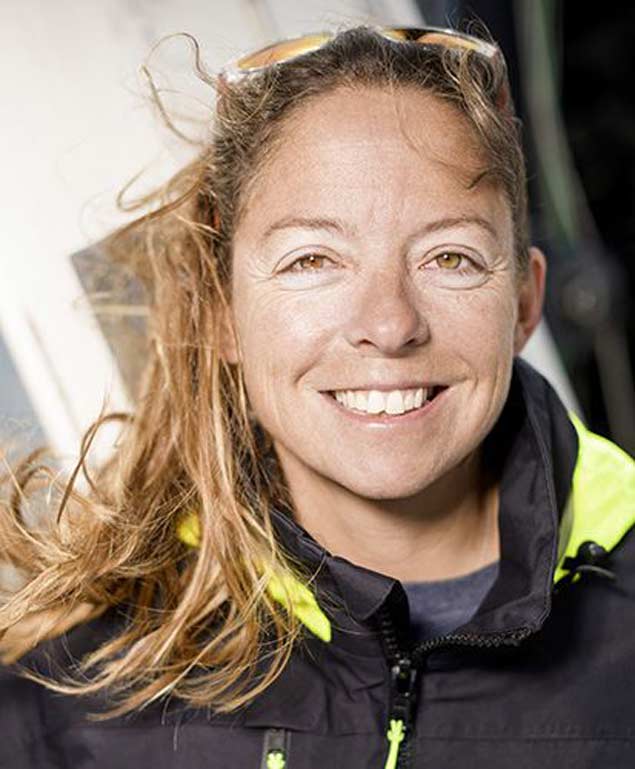 Alexia Barrier, tired but happy after completing another solo challenge. Her finish in last year’s Transatlantic Route de Rhum has already qualified her for next year’s Vendee Globe Solo
Alexia Barrier, tired but happy after completing another solo challenge. Her finish in last year’s Transatlantic Route de Rhum has already qualified her for next year’s Vendee Globe Solo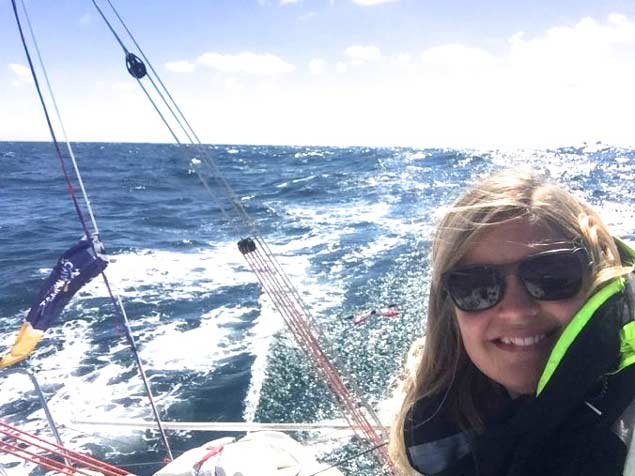 Joan Mulloy where she is happiest – in open water with the boat going well
Joan Mulloy where she is happiest – in open water with the boat going well
In France, the regions are in competition with each other and internationally to attract such events. The Port of Brest, in one example, has taken over the historic OSTAR. But in smaller countries, it’s a case of the entire nation wheeling in support, as is being seen this morning in Malta where a major offshore race – once of interest to only a select few on the island – is now high on the priority list of the government’s promotion department.
Today, in the almost absurdly picturesque and distinctly crowded history-laden Grand Harbour of Valetta in Malta, it will take seven different starts to get the total fleet of 112 boats in the 40th Edition of the 606-mile Rolex Middle Sea Race cleanly away. From this inevitably tense and crowded start to a multi-island-rounding course in the Mediterranean, they’ll have the finishers back in port and the results declared by the time the Transat Jacques Vabre comes top of the agenda on Sunday October 27th.
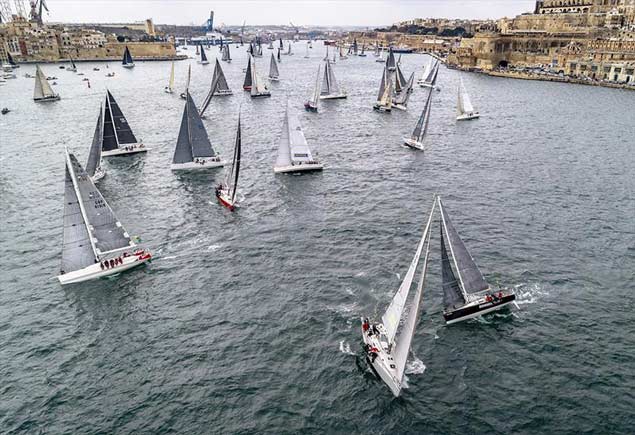 Classic start for a classic race – the Rolex Middle Sea race tacking out of Grand Harbour Valetta in close formation. Photo Rolex/Kurt Arrigo
Classic start for a classic race – the Rolex Middle Sea race tacking out of Grand Harbour Valetta in close formation. Photo Rolex/Kurt Arrigo
For devoted inshore sailing enthusiasts who think that night-time is when you should be comfortably ashore in bed after a good day’s sailing in pleasant coastal surroundings, both of these major international events are simply seen as being lumped under the general heading of “Offshore & Ocean Racing”. And their overall response is “Thanks but no thanks…..”
Yet for aficionados, not only are they long hauls which will be avidly followed throughout with total dedication, but the very different types of offshore racing which they exemplify are all part of the fascination.
For the Rolex Middle Sea Race is one contemporary version of the classic Royal Ocean Racing Club “long one”. These are the well-established events such as the Fastnet Race itself, the Sydney-Hobart, the RORC Caribbean 600 and the Newport-Bermuda, all of which fall within the 600-650 mile distance range. Also generally included is the Round Ireland, even though it clocks up 704 miles. And all – when they were founded – were regarded in their day as marathons, a title which most participants continue to happily support.
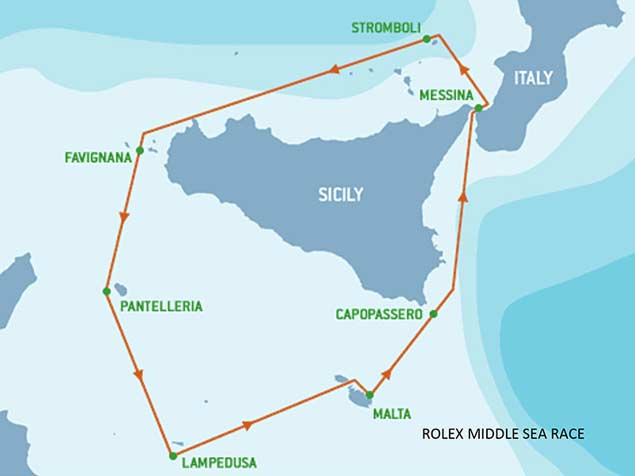 The Middle Sea Race course – anyone who thinks it’s a walk in the park is often brutally surprised
The Middle Sea Race course – anyone who thinks it’s a walk in the park is often brutally surprised
But with the international ocean racing bar now being set very high by the Vendee Globe with its off-the-wall IMOCA 60s, public perception may have become more muted in response to the more traditional events. Yet the fact that the biennial Fastnet Race’s basic entry limit for 350 boats is hit within minutes of the online acceptance opening for business tells us that the mystique of these classics is strong, and for recreational sailors of competitive offshore interest, they are very much something they want to have in their CV.
Because there’s a real continuity to these events - with a shared sponsor in Rolex - part of the interest is in discerning special patterns. So although George David’s great round Ireland record-holding Rambler 88 will be seeing can she better the Middle Sea Race’s 47 hours 55 minutes and 3 seconds record he set with Rambler 90 in 2007 (a decidedly tense-making four minutes and 57 seconds inside the magic 48-hours barrier), there’ll be every bit as much interest in how things go for Wizard, the Askew brothers’ former Volvo 70 from America.
Originally Groupama 4 and designed by Juan Kouyoumdjian for the 2011-12 Volvo Ocean Race - which she won for France skippered by Franck Cammas - this splendid “old” warhorse has by no means gone gently into the sweet night of retirement.
On the contrary, she reappeared under New Zealand ownership for the 2016 Rolex Sydney Hobart re-named Giacomo, owned and skippered by wine magnate Jim Delegat, who had several of his family in the crew, including the youngest race participant, 18-year-old James Delegat Jnr, as Australian rules preclude anyone under 18 doing this race. Conditions suited a Volvo 70 almost to perfection and they managed second on line honours among much larger craft, and this in time converted into the overall win.
Thus Giacomo was arguably the first of the former Volvo 70s – they initially appeared in 2005 - to make a significant input outside the Volvo Ocean Race bubble. But the former Groupama 4 was only getting going. Having won outright in what was only his third Sydney-Hobart, Jim Delegat decided to get out while still on top, and soon he sold Giacomo on to Peter and Dave Askew from America, who lavished much TLC on a craft renamed again. She became Wizard, and she lived up to her new name from the get go.
 The former Volvo 70 Wizard making knots. One of the world’s most successful offshore racers, since 2012 under three different names she has won the Volvo Ocean Race, the Sydney-Hobart, the RORC Caribbean 600, the Transatlantic, and the Fastnet. Photo: Rolex
The former Volvo 70 Wizard making knots. One of the world’s most successful offshore racers, since 2012 under three different names she has won the Volvo Ocean Race, the Sydney-Hobart, the RORC Caribbean 600, the Transatlantic, and the Fastnet. Photo: Rolex
Skippered for the brothers by Charlie Enright, Wizard has continued as a real life-enhancer on the international offshore scene, and with the Volvo Ocean Race and the Rolex Sydney-Hobart trophies already in the collection, she hit the 2019 programme in style, taking line honours in February’s big-fleet RORC Caribbean 600, and then correcting into the overall win.
Next outing was the RORC/NYYC Transatlantic Race with the weather in the North Atlantic in an increasingly obtuse mood, with calms later plaguing the smaller boats. But it was by no means a cakewalk for the biggies either, yet Wizard called it just right, and took the overall win.
Then up came the Rolex RORC Fastnet Race on 3rd August 2019, and in the livestream at the start, as the camera panned past Wizard somebody in the commentary box let slip a remark to the effect that this was “an old Volvo 70, not really suited to this race”, or words to that effect.
 Having made a brilliant job of the tricky outward stages to reach the Fastnet Rock, Wizard did even better on he final stage to Plymouth to win overall. Photo: RolexNow that was some hostage to fortune….not only did Wizard make such a perfect job of getting through the sticky calm-plagued patch between Start Point and the Lizard that we assumed the great Ian Moore must be the navigator on board (he wasn’t), but then when Wizard’s group arrived at the Fastnet itself, a complex frontal system was going through to baffle many. Yet Charlie Enright called the sail changes to precise perfection, they piled on the miles to a challenging position, and swept into Plymouth to correct into such a strong time that soon Wizard was declared the overall winner.
Having made a brilliant job of the tricky outward stages to reach the Fastnet Rock, Wizard did even better on he final stage to Plymouth to win overall. Photo: RolexNow that was some hostage to fortune….not only did Wizard make such a perfect job of getting through the sticky calm-plagued patch between Start Point and the Lizard that we assumed the great Ian Moore must be the navigator on board (he wasn’t), but then when Wizard’s group arrived at the Fastnet itself, a complex frontal system was going through to baffle many. Yet Charlie Enright called the sail changes to precise perfection, they piled on the miles to a challenging position, and swept into Plymouth to correct into such a strong time that soon Wizard was declared the overall winner.
 Charlie Enright of Wizard, a skipper of genius
Charlie Enright of Wizard, a skipper of genius Sporting owners – David and Peter Askew in Antigua, February 2019, after Wizard had been declared overall winner of the RORC Caribbbean 600
Sporting owners – David and Peter Askew in Antigua, February 2019, after Wizard had been declared overall winner of the RORC Caribbbean 600
By this time Wizard was so cheerfully the ambassador for American offshore racing that it was natural to overlook the fact that her take-everything victory was in fact yet another corner-stone in the French domination of the Rolex Fastnet Race 2019. But while she may have been French in her origins, it’s only right and proper to credit that David & Peter Askew and Charlie Enright, plus Jim Delegat before them, have put their stamp firmly on a record of unrivalled and varied success which extends directly back to Franck Cammas in 2012.
So with the Volvo Ocean, Sydney-Hobart, RORC Caribbean 600, Transatlantic 2019 and Fastnet Race securely under her belt, Magic is surely the boat to watch as the fleet set about exiting Grand Harbour Valetta this morning for a challenge whose name suggests balmy Mediterranean sailing, yet experience has shown that the Middle Sea Race in October plumb in the midst of Mare Nostrum can be tough and then some.
 Ireland’s Barry Hurley will be racing a Dazcat 195 catamaran in the Middle Sea Race today – this is how she looks in steady going……..
Ireland’s Barry Hurley will be racing a Dazcat 195 catamaran in the Middle Sea Race today – this is how she looks in steady going……..
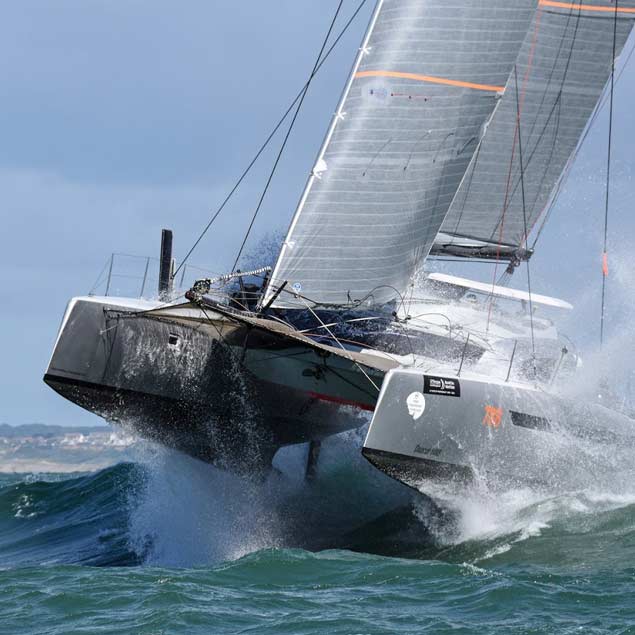 ……and this is the Dazcat 1495 in a bit of a breeze
……and this is the Dazcat 1495 in a bit of a breeze
Ireland’s most experienced participants in it is Barry Hurley, with something like 14 tilts already logged for this circuit of islands which include - for something a little different - the active volcano of Stromboli. Former OSTAR Class winner Hurley has been well in the frame in mono-hulls in the Middle Sea Race several times, but this year he’s trying a new approach in a multi-hull, in this case the DazCat 1495 Apollo.
It requires very special skills and nerves of steel to race a catamaran flat out along a course which takes in coasting along steep mountains and through areas notorious for sudden squalls, but if the chips fall the right way the rewards are immense.
A more orthodox entry with Irish interest is ISORA Pwllheli-based skipper Andrew Hall with his J/121 JackHammer, a much roomier proposition than the vintage ultra-slim J/125 JackKnife which he raced – usually in the frame - in the Irish Sea during the 2019 season.
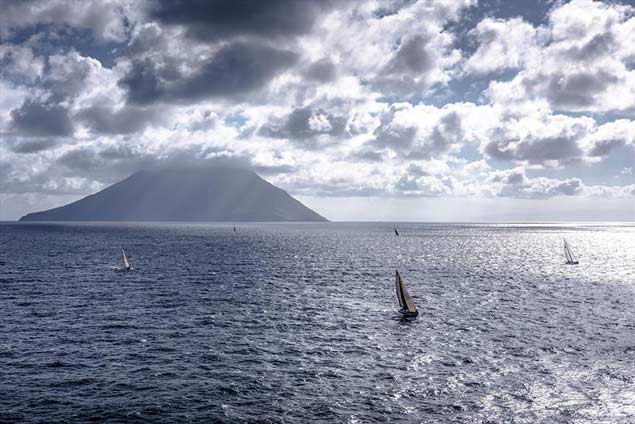 How’s this four a mark of the course? There’s no guarantee that the Stromboli volcano won’t be erupting as the Middle Sea Race fleet rounds it. Photo: Rolex
How’s this four a mark of the course? There’s no guarantee that the Stromboli volcano won’t be erupting as the Middle Sea Race fleet rounds it. Photo: Rolex
His crew includes NYC sailor Willie Despard, so we have direct interest in at least two boats, and doubtless, other Irish participants will emerge as this intriguing race progresses. But anyone with an interest in the general wellbeing of world offshore racing cannot help but feel involved in the continuing extraordinary progress of Wizard. This is one well-sailed and classy boat which has given many people an immense amount of sporting satisfaction, and though it's grossly unfair to be heaping so much expectation on her prospects in the Middle Sea Race, but that’s the way it is. And we can be consoled by her string of established successes if things don’t work out to perfection this time round in a complex race in which the defending champion is France’s very special Gery Trentesaux in his JPK 11.80 Courier Recommande.
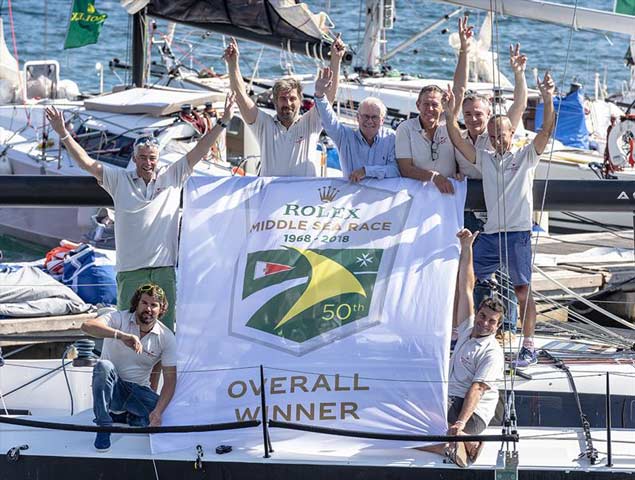 Defending champion: France’s veteran superstar Gery Trentesaux (centre) is defending title-holder in today’s Middle Sea Race
Defending champion: France’s veteran superstar Gery Trentesaux (centre) is defending title-holder in today’s Middle Sea Race
As to how things will be shaping up in a week’s time in the final countdown to the Jacques Vabre start off Le Havre, Alexia Barrier and Joan Mulloy don’t pretend that their 1998-built oldie 4myplanet – a pioneering Marc Lombard design in her day - is anything other than a sporting entry when set against the likes of Alex Thomson and Neal McDonald in the former’s latest addition to the Huge Boss line, and much is also expected of other fresh-out of-the-wrappings IMOCA 60s like Clarice Cremer and Armel le Cleach in Banque Populaire.
After all, with the basic budget of €5 million which created the new Hugo Boss, you could buy a dozen vintage IMOCA 60s…….
 The latest – Banque Populaire X continues a long line of financial services sponsorship in French ocean racing
The latest – Banque Populaire X continues a long line of financial services sponsorship in French ocean racing 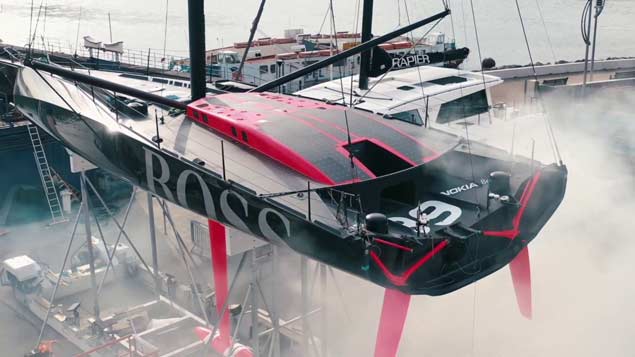 Ultimate racing machine? The new Hugo Boss will be using the Transat Jacques Vabre 2019 as a debut event.
Ultimate racing machine? The new Hugo Boss will be using the Transat Jacques Vabre 2019 as a debut event.
Mayo Sailor Joan Mulloy Sails up the River Thames in Granuaile Re-enactment
County Mayo solo sailor, Joan Mulloy of Westport, will sail along the River Thames to Tower Bridge, completing a special journey that replicates one made by her formidable ancestor, the legendary Granuaile, over 400 years ago.
Under black sails emblazoned with her name, Grace O’Malley Irish Pirate Queen, Joan has retraced the route from Clew Bay in Mayo to London, a journey that saw the Irish Pirate Sea Queen come face to face with the Virgin Queen in their historic meeting in late summer of 1593.
In keeping with the re-enactment, Joan will bring a special presentation bottle of Grace O’Malley Irish Whiskey on board commemorating the famous meeting which founded a mutual respect between these two formidable ladies, along with a unique friendship. The legend recalls that Grace gifted of a bottle of Irish whiskey to the Queen who was well known for her partiality to ‘uisce beatha’, having stocks of it delivered to her court.
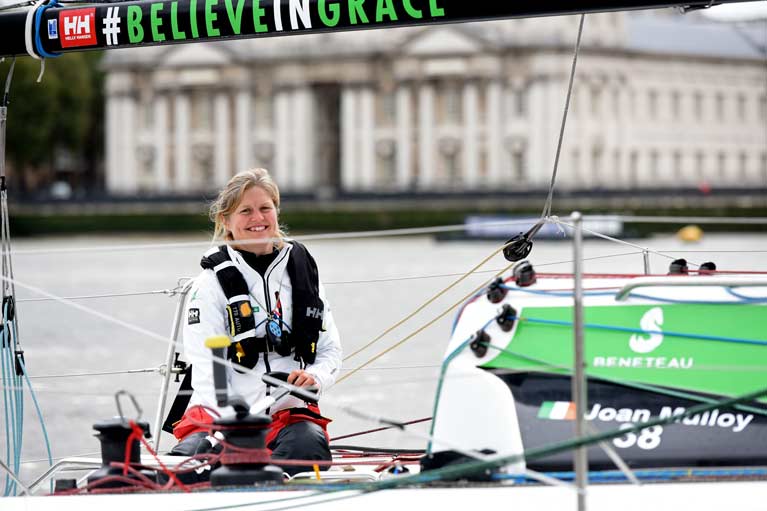 Joan Mulloy on the Thames Photo: Rick Tomlinson
Joan Mulloy on the Thames Photo: Rick Tomlinson
Whether the whiskey aided in appeasing her highness is not documented, but records reveal that for Grace the trip was successful in its aim. Grace received ‘clemencie and favour’ from Queen Elizabeth I, who following the meeting, released Grace’s son Tibbot, restored his lands and gave the royal assent that Grace could continue her business of ‘maintenance by land and sea’ without hindrance or interference from the Queen’s governors.
Mulloy was one of two Irish entrants in this summer's 50th edition of the arduous single-handed French marathon Figaro Race finishing 38th from 44 starters. More here
Figaro Sailors Reach Kinsale Finish, Hopes of Top Irish Result Fades at the Fastnet Rock
From the highs of a top ten position earlier this week hopes have faded for a strong home waters finish for either Irish entry in the opening leg of the 50th La Solitaire URGO Le Figaro into Kinsale. Tonight Tom Dolan lies 39th and Joan Mulloy 44th in a fleet of 47 with approximately 40 miles to sail to the finish.
Meanwhile, the three-way battle to stage one deliverance at the Old Head of Kinsale was won by overall winner in 2016, Yoann Richomme who was doing all he could to hold on to a lead of just under half a mile late this afternoon, seeking to close out what would be a well-deserved victory on the first stage of the Figaro.
"Richomme, 35 from Lorient, was being chased by talented, hard driving 21 year old rookie, Tom Laperche"
First around the Fastnet Rock at 1229hrs local time, Richomme, 35 from Lorient, was being chased by talented, hard driving 21 year old rookie, Tom Laperche (Bretagne CMB Espoir) and Pierre Leboucher (Guyot Environement) as they race towards the finish line of the course which is to be shortened by 11 miles at the Old Head of Kinsale. There was nothing between the three as they traded gybes and a stage which has lasted four nights and four days since starting from the bay of La Baule near Nantes, hangs in the balance.
Deliverance from one of the longest and most challenging Solitaire legs of recent years will doubtless feel magical for the top trio who were 15 minutes clear of the fourth placed solo skipper when they rounded the mythical rock in very light winds. But since the turn they have made decent speeds under spinnaker and should cross the line at around 1900hrs local time this evening.
Richomme, outstanding winner of the Route du Rhum in Class 40 last November, has come into this race feeling none of the pressure heaped on some of his rivals. After Volvo Ocean Race winning skipper Charles Caudrelier seized an opportunity to become co-skipper of the Gitana Ultime, Richomme was drafted in as a late replacement for Caudrelier for whom he started out in the Figaro as preparateur.
He and Leboucher led a group who took a middle course off Ushant and then stuck with it across the approaches to the Channel and over the Celtic Sea. Their choice allowed them to gain relative to a strong pack who went offshore to the west, which ultimately suffered last night when the wind swung more to the north.
Around three miles behind Richomme, veteran Loïck Peyron, the elder statesman of the course at 59 years old will be happy to hold on to the sixth place he was in during this afternoon's sunny slide east along the Irish coast to the finish line. Peyron is returning to La Solitaire for the first time since he was sixth overall in 2003. He had his 'roaring 50s' rivals Michel Desjoyeaux, 53, less than a mile behind in ninth place and Alain Gautier, 57, in 12th. Peyron said at the Fastnet: "I'm 30 miles from the finish. It's not bad to avoid the last vagaries of the wind on this coast to get finished tonight "
Highly fancied favourite Armel Le Cléac'h (Banque Populaire) may have rescued some of his chances of a good finish overall by recovering from being among the back markers on Tuesday to be 13th on the reach in this afternoon, but the same might not hold true for the group of top seeds who went west, led by three times winner Yann Eliès (Saint Michel). Eliès - who led during the second day of racing - was nearly three and a half hours behind at the Fastnet Rock.
Admirable recoveries appear to have been achieved by international skippers Justine Mettraux of Switzerland on course for 14th and Brit Alan Roberts (Seacat Services) who was 16th, both around one hour behind the leaders.



























